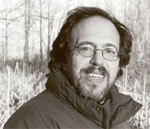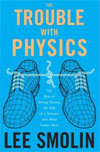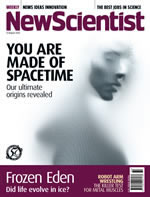Theoretical
physicists working in the rarefied field of loop quantum gravity have
developed a way to describe elementary particles as merely tangles in
space. If they are right, it could be the most profound scientific generalisation
of all time, in which everything in the universe emerges from a simple
network of relationships, with no fundamental building blocks at all. — New
Scientist, Editorial [12 August 06]
BRAIDS

Lee Smolin
About
a decade ago, in my book The Third
Culture (1995), Lee Smolin's chapter ("A
Theory of the Whole Universe") began with the following comments:
"What
is space and what is time? This is what the problem of quantum gravity
is about. In general relativity, Einstein gave us not only a theory
of gravity but a theory of what space and time are — a theory
that overthrew the previous Newtonian conception of space and time.
The problem of quantum gravity is how to combine the understanding
of space and time we have from relativity theory with the quantum theory,
which also tells us something essential and deep about nature. If we
can do this, we'll discover a single unified theory of physics that
will apply to all phenomena, from the very smallest scales to the universe
itself. This theory will, we're quite sure, require us to conceive
of space and time in new ways that take us beyond even what relativity
theory has taught us.
"But, beyond even this, a quantum theory of gravity must be a theory
of cosmology. As such, it must also tell us how to describe the whole
universe from the point of view of observers who live in it — for
by definition there are no observers outside the universe. This leads
directly to the main issues we're now struggling with, because it seems
very difficult to understand how quantum theory could be extended from
a description of atoms and molecules to a theory of the whole universe.
As Bohr and Heisenberg taught us, quantum theory seems to make sense
only when it's understood to be the description of something small and
isolated from its observer — the observer is outside of it. For
this reason, the merging of quantum theory and relativity into a single
theory must also affect our understanding of the quantum theory. More
generally, to solve the problem of quantum gravity we'll have to invent
a good answer to the question: How can we, as observers who live inside
the universe, construct a complete and objective description of it?"
Discover Magazine
had run a cover story proclaiming Smolin "The New Einstein".
It may have impressed the general reader, but not mainstream physicists.
As cosmologist Alan Guth, father of the inflationary theory of the Universe,
noted in The Third Culture:
"The
relativity physicists belong to a small club. It's a club that has
yet to convince the majority of the community that the approach they're
pursuing is the right one. Certainly Smolin is welcome to come and
give seminars, and at major conferences he and his colleagues are invited
to speak. The physics community is interested in hearing what they
have to say. But the majority looks to the superstring approach to
answer essentially the same questions."
Also weighing
in was particle physicist and Nobel Laureate Murray Gell-Mann:
"Smolin?
Oh, is he that young guy with those crazy ideas? He may not be wrong!"
 A
decade later, Smolin's ideas are beginning to get traction. New Scientist has
published a cover story [12 August 06] reporting on the work on "Braids" and
Loop Quantum Gravity by Smolin, Carlo Rovelli, Sundance Bilson-Thompson,
and Fotini Markopoulou. An accompanying editorial proclaims that "it
could be the most profound scientific generalisation of all time." A
decade later, Smolin's ideas are beginning to get traction. New Scientist has
published a cover story [12 August 06] reporting on the work on "Braids" and
Loop Quantum Gravity by Smolin, Carlo Rovelli, Sundance Bilson-Thompson,
and Fotini Markopoulou. An accompanying editorial proclaims that "it
could be the most profound scientific generalisation of all time."
Is it time
to overthrow decades of work on string theory? The jury is out on the
ideas generated by Smolin and his colleagues, but the question is now
being asked by more than a few physicists.
— JB
LEE SMOLIN,
a theoretical physicist, is the founding member and research physicist
at the Perimeter Institute in Waterloo Canada. He is the author of The
Life of The Cosmos, Three Roads to Quantum Gravity, and the recently
published The
Trouble With Physics.
Lee
Smolin's EDGE bio page
LINKS:
"Loop Quantum
Gravity: Lee Smolin" [2.24.03]
"Smolin
" [8.18.04]
BEYOND EDGE:
"Quantum
gravity and the standard model" [3.3.06]
3 Mar 2006
By Sundance O. Bilson-Thompson, Fotini Markopoulou, Lee Smolin

12 August 2006
Editorial:
Loop quantum gravity increases its pull
String
theory's main rival has earned the right to be taken seriously - it
could be the most profound scientific generalisation of all time
THE accepted
idea of matter is that it is made up of minuscule particles guided by
quantum force fields. This is already far removed from the common-sense
view that matter is, well, just chunks of stuff. If that seems hard enough
to take, then brace yourself for another step away from common sense.
Theoretical
physicists working in the rarefied field of loop quantum gravity have
developed a way to describe elementary particles as merely tangles in
space (see "Out of the void"). If they are right, it could
be the most profound scientific generalisation of all time, in which
everything in the universe emerges from a simple network of relationships,
with no fundamental building blocks at all.
Up to now,
loop quantum gravity has seemed like a poor relation of string theory,
which for years has been the most popular route to a "theory of
everything" in which all the forces of nature - and especially gravity,
the outsider among them - are united. ...
Subscription
required until Monday 21 August — free thereafter
[...continue]
 NEW
SCIENTIST COVER STORY NEW
SCIENTIST COVER STORY
12 August 2006
YOU ARE MADE OF SPACE-TIME
Our Ultimate Origins Revealed
Davide Castelvecchi
Physical
particles may seem very different from the space-time they inhabit,
but what if the two are one and the same thing? New Scientist investigates
LEE SMOLIN
is no magician. Yet he and his colleagues have pulled off one of the
greatest tricks imaginable. Starting from nothing more than Einstein's
general theory of relativity, they have conjured up the universe. Everything
from the fabric of space to the matter that makes up wands and rabbits
emerges as if out of an empty hat.
It is an impressive
feat. Not only does it tell us about the origins of space and matter,
it might help us understand where the laws of the universe come from.
Not surprisingly, Smolin, who is a theoretical physicist at the Perimeter
Institute in Waterloo, Ontario, is very excited. "I've been jumping
up and down about these ideas," he says.
This promising
approach to understanding the cosmos is based on a collection of theories
called loop quantum gravity, an attempt to merge general relativity and
quantum mechanics into a single consistent theory...
Subscription
required until Monday 21 August — free thereafter
[...continue]
|